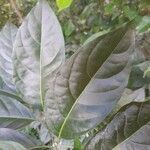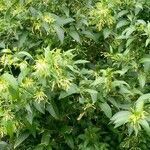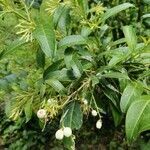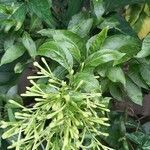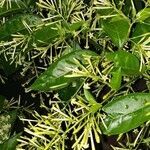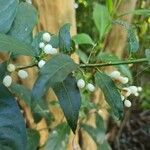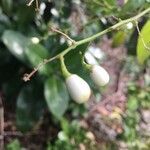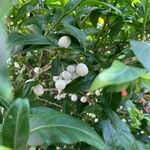Large shrub or small tree to 4 m high; young twigs sparsely pubescent. Leaves lanceolate-elliptic; lamina 10–15 cm long, 4–7 cm wide, the midrib pubescent below; petiole 5–10 mm long. Inflorescence an often congested, terminal, leafy panicle of spike-like racemes; flowers numerous, sessile or on pedicels to 3 mm long, subtended by leafy, linear bracts 3–10 mm long. Calyx c. 2.5 mm long; lobes triangular, c. 0.8 mm long. Corolla greenish-yellow, slightly enlarged upwards; lobes c. 4 mm long. Stamens inserted in upper half of corolla-tube; filaments c. 3 mm long, with an erect process just below point of insertion, retrorsely pubescent where adnate to tube; anthers 0.5 mm long. Style 15–16 mm long. Berry 8–10 mm diam., white. Seeds prismatic, c. 4 mm long.
Shrub, generally 1.5-2.5 m high, almost glabrous. Petiole c. 1 cm long. Lamina 5-15 × 1.5-6 cm, elliptic to elliptic-ovate, glabrous or with minute puberulence when young; base cuneate to rounded, sometimes asymmetric; apex abruptly acuminate. Panicle open, large; fls usually shortly pedicellate, sometimes subsessile, fragrant nocturnally. Calyx 2-3 mm long; lobes > 1 mm long, ± triangular, densely ciliolate, acute. Corolla 1.5-2 cm long, pale green or greenish white; tube cylindric to narrow-funnelform, widening slightly above; lobes 3 mm long, eventually spreading, glabrous except for shortly villous margins. Fr. c. 0.5-1 cm diam., globose to ellipsoid, white, glossy.
Shrubs erect or sprawling, 1-3 m tall; young growth puberulent, glabrescent. Branches slender. Petiole 0.8-2 cm; leaf blade oblong-ovate or oblong-lanceolate, 6-15 × 2-4.5 cm, entire. Inflorescences drooping, many-flowered, axillary or terminal racemose panicles, 7-10 cm. Flowers strongly night scented. Pedicel 1-5 mm. Calyx campanulate, 2-3 × 1-1.5 mm; lobes deltoid, 0.5-0.8 mm. Corolla greenish or whitish yellow, 1.5-2.5 cm, tube slightly contracted at throat, lobes 3-4 mm. Filaments with dentate appendages, usually puberulent at point of insertion. Ovary ca. l mm. Berry white, juicy, oblong or globose, 6-10 × 4-10 mm. Seeds 1-5, ellipsoid, 3.5-4.5 mm.
